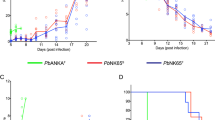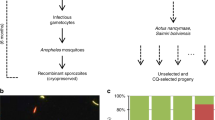Abstract
The recombinant congenic mouse strains AcB55 and AcB61 are extremely resistant to malaria (Plasmodium chabaudi AS) despite the presence of susceptibility alleles at the known Char1/Char2 resistance loci. Resistance in AcB55 and AcB61 is controlled by a locus on chromosome 3 (Char4) shown to be allelic with or tightly linked to a loss-of-function mutation in pyruvate kinase (Pklr). AcB55 and AcB61 show important splenomegaly prior to infection caused by the expansion of the red pulp, and display histological signs of extramedullary erythropoiesis in the liver. Examination of splenic cell populations by flow cytometry demonstrates elevated numbers of TER119-positive erythroid precursor cells (>30% of total spleen cells), while RNA expression studies show elevated expression of erythrocyte-specific transcripts such as globin, transferrin receptor, and Nramp2/Slc11a2 in the spleen of both strains. Hematological profiling in both strains is consistent with the presence of anemia as evidenced by low total erythrocyte counts, decreased hemoglobin, as well as abnormally high numbers of circulating reticulocytes (15–20%). These results strongly suggest that the mutant Pklr allele (Pklr269A) of AcB55/61 strains causes hemolytic anemia compensated by constitutive erythropoiesis, which in turn protects the mice against P. chabaudi infection. The possible molecular basis of the Pklr protective effect is discussed and is under current investigation in these two strains.
This is a preview of subscription content, access via your institution
Access options
Subscribe to this journal
Receive 6 digital issues and online access to articles
$119.00 per year
only $19.83 per issue
Buy this article
- Purchase on Springer Link
- Instant access to full article PDF
Prices may be subject to local taxes which are calculated during checkout





Similar content being viewed by others
References
Hill AV . The immunogenetics of human infectious diseases. Annu Rev Immunol 1998; 16: 593–617.
Fortin A, Stevenson MM, Gros P . Susceptibility to malaria as a complex trait: big pressure from a tiny creature. Hum Mol Genet 2002; 11: 2469–2478.
Tournamille C, Colin Y, Cartron JP, Le Van Kim C . Disruption of a GATA motif in the Duffy gene promoter abolishes erythroid gene expression in Duffy-negative individuals. Nat Genet 1995; 10: 224–228.
Allison AC . Protection afforded by sickle-cell trait against subtertian malarial infection. BMJ 1954: 290–294.
Flint J, Hill AV, Bowden DK et al. High frequencies of alpha-thalassaemia are the result of natural selection by malaria. Nature 1986; 321: 744–750.
Weatherall DJ . Phenotype-genotype relationships in monogenic disease: lessons from the thalassaemias. Nat Rev Genet 2001; 2: 245–255.
Tishkoff SA, Varkonyi R, Cahinhinan N et al. Haplotype diversity and linkage disequilibrium at human G6PD: recent origin of alleles that confer malarial resistance. Science 2001; 293: 455–462.
Ruwende C, Hill A . Glucose-6-phosphate dehydrogenase deficiency and malaria. J Mol Med 1998; 76: 581–588.
Bunyaratvej A, Butthep P, Kaewkettong P, Yuthavong Y . Malaria protection in hereditary ovalocytosis: relation to red cell deformability, red cell parameters and degree of ovalocytosis. Southeast Asian J Trop Med Public Health 1997; 28: 38–42.
Patel SS, Mehlotra RK, Kastens W, Mgone CS, Kazura JW, Zimmerman PA . The association of the glycophorin C exon 3 deletion with ovalocytosis and malaria susceptibility in the Wosera, Papua New Guinea. Blood 2001; 98: 3489–3491.
Hill AV, Allsopp CE, Kwiatkowski D et al. Common west African HLA antigens are associated with protection from severe malaria. Nature 1991; 352: 595–600.
McGuire W, Hill AV, Allsopp CE, Greenwood BM, Kwiatkowski D . Variation in the TNF-alpha promoter region associated with susceptibility to cerebral malaria. Nature 1994; 371: 508–510.
Fortin A, Stevenson MM, Gros P . Complex genetic control of susceptibility to malaria in mice. Genes Immun 2002; 3: 177–186.
Foote SJ, Burt RA, Baldwin TM et al. Mouse loci for malaria-induced mortality and the control of parasitaemia. Nat Genet 1997; 17: 380–381.
Fortin A, Belouchi A, Tam MF et al. Genetic control of blood parasitaemia in mouse malaria maps to chromosome 8. Nat Genet 1997; 17: 382–383.
Burt RA, Baldwin TM, Marshall VM, Foote SJ . Temporal expression of an H2-linked locus in host response to mouse malaria. Immunogenetics 1999; 50: 278–285.
Fortin A, Diez E, Rochefort D et al. Recombinant congenic strains derived from A/J and C57BL/6J: a tool for genetic dissection of complex traits. Genomics 2001; 74: 21–35.
Fortin A, Cardon LR, Tam M, Skamene E, Stevenson MM, Gros P . Identification of a new malaria susceptibility locus (Char4) in recombinant congenic strains of mice. Proc Natl Acad Sci USA 2001; 98: 10793–10798.
Min-Oo G, Fortin A, Tam MF, Nantel A, Stevenson MM, Gros P . Pyruvate kinase deficiency in mice protects against malaria. Nat Genet 2003; 35: 357–362.
Herzberg AJ . Color Atlas of Normal Cytology. Churchill Livingstone: New York, 1999, pp 256–263.
Morimoto M, Kanno H, Asai H et al. Pyruvate kinase deficiency of mice associated with nonspherocytic hemolytic anemia and cure of the anemia by marrow transplantation without host irradiation. Blood 1995; 86: 4323–4330.
Weatherall DJ, Clegg JB . Genetic variability in response to infection: malaria and after. Genes Immun 2002; 3: 331–337.
Shear HL, Roth Jr EF, Fabry ME et al. Transgenic mice expressing human sickle hemoglobin are partially resistant to rodent malaria. Blood 1993; 81: 222–226.
Shear HL, Roth Jr EF, Ng C, Nagel RL . Resistance to malaria in ankyrin and spectrin deficient mice. Br J Haematol 1991; 78: 555–560.
Yuthavong Y, Bunyaratvej A, Kamchonwongpaisan S . Increased susceptibility of malaria-infected variant erythrocytes to the mononuclear phagocyte system. Blood Cells 1990; 16: 591–597.
Modiano D, Luoni G, Sirima BS et al. Haemoglobin C protects against clinical Plasmodium falciparum malaria. Nature 2001; 414: 305–308.
Allen SJ, O’Donnell A, Alexander ND et al. alpha+-Thalassemia protects children against disease caused by other infections as well as malaria. Proc Natl Acad Sci USA 1997; 94: 14736–14741.
Fairhurst RM, Fujioka H, Hayton K, Collins KF, Wellems TE . Aberrant development of Plasmodium falciparum in hemoglobin CC red cells: implications for the malaria protective effect of the homozygous state. Blood 2003; 101: 3309–3315.
Ruwende C, Khoo SC, Snow RW et al. Natural selection of hemi- and heterozygotes for G6PD deficiency in Africa by resistance to severe malaria. Nature 1995; 376: 246–249.
McMullin MF . The molecular basis of disorders of red cell enzymes. J Clin Pathol 1999; 52: 241–244.
Jacobasch G, Rapoport SM . Hemolytic anemias due to erythrocyte enzyme deficiencies. Mol Aspects Med 1996; 17: 143–170.
Roth Jr E . Plasmodium falciparum carbohydrate metabolism: a connection between host cell and parasite. Blood Cells 1990; 16: 453–460 (discussion 461–456).
Zanella A, Bianchi P . Red cell pyruvate kinase deficiency: from genetics to clinical manifestations. Baillieres Best Pract Res Clin Haematol 2000; 13: 57–81.
Oelshlegel Jr FJ, Sander BJ, Brewer GJ . Pyruvate kinase in malaria host–parasite interaction. Nature 1975; 255: 345–347.
Demant P, Hart AA . Recombinant congenic strains—a new tool for analyzing genetic traits determined by more than one gene. Immunogenetics 1986; 24: 416–422.
Yap GS, Stevenson MM . Plasmodium chabaudi AS: erythropoietic responses during infection in resistant and susceptible mice. Exp Parasitol 1992; 75: 340–352.
Stevenson MM, Lyanga JJ, Skamene E . Murine malaria: genetic control of resistance to Plasmodium chabaudi. Infect Immun 1982; 38: 80–88.
Sebastiani G, Blais V, Sancho V et al. Host immune response to Salmonella enterica serovar Typhimurium infection in mice derived from wild strains. Infect Immun 2002; 70: 1997–2009.
Lam-Yuk-Tseung S, Govoni G, Forbes J, Gros P . Iron transport by Nramp2/DMT1: pH regulation of transport by 2 histidines in transmembrane domain 6. Blood 2003; 101: 3699–3707.
Acknowledgements
We are indebted to Dr Emil Skamene (McGill University Health Center) and Emerillon Therapeutics Inc. for providing AcB55 and AcB61 recombinant congenic strains. This work was supported by research grants from Burroughs Wellcome Fund and the Canadian Institutes of Health Research (CIHR) to MMS and PG and the Canadian Genetic Disease Network to PG. PG is a Distinguished Scientist of the CIHR.
Author information
Authors and Affiliations
Corresponding author
Rights and permissions
About this article
Cite this article
Min-Oo, G., Fortin, A., Tam, MF. et al. Phenotypic expression of pyruvate kinase deficiency and protection against malaria in a mouse model. Genes Immun 5, 168–175 (2004). https://doi.org/10.1038/sj.gene.6364069
Received:
Accepted:
Published:
Issue Date:
DOI: https://doi.org/10.1038/sj.gene.6364069
Keywords
This article is cited by
-
A Sri Lankan girl with a new genetic variant in the PKLR gene causing pyruvate kinase deficiency: a case report
Journal of Medical Case Reports (2021)
-
Host genetics in malaria: lessons from mouse studies
Mammalian Genome (2018)
-
Safe and Efficient Gene Therapy for Pyruvate Kinase Deficiency
Molecular Therapy (2016)
-
Host resistance to malaria: using mouse models to explore the host response
Mammalian Genome (2011)
-
Mapping of Char10, a novel malaria susceptibility locus on mouse chromosome 9
Genes & Immunity (2010)



